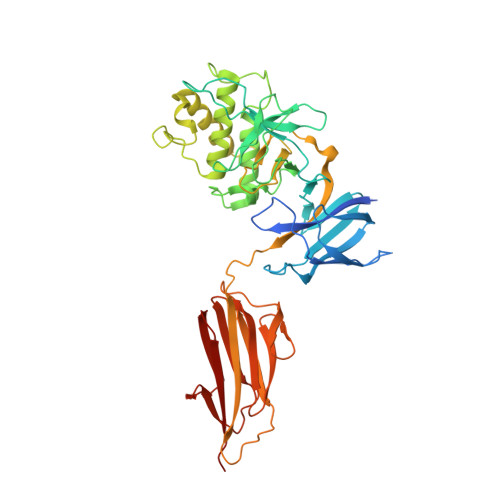Intramolecular Isopeptide But not Internal Thioester Bonds Confer Proteolytic and Significant Thermal Stability to the S. Pyogenes Pilus Adhesin Spy0125.
Walden, M., Crow, A., Nelson, M.D., Banfield, M.J.(2014) Proteins 82: 517
- PubMed: 24123467
- DOI: https://doi.org/10.1002/prot.24420
- Primary Citation of Related Structures:
4BUG - PubMed Abstract:
Streptococcus pyogenes and other Gram-positive bacterial pathogens present long macromolecular filaments known as pili on their surface that mediate adhesion and colonization. These pili are covalent polymers, assembled by sortases. Typically, they comprise a putative adhesin at their tip, a backbone subunit present in multiple copies and a basal subunit that is covalently anchored to the peptidoglycan layer of the cell surface. The crystal structures of pilin subunits revealed the presence of unusual covalent linkages in these proteins, including intramolecular isopeptide and internal thioester bonds. The intramolecular isopeptide bonds in backbone pilins are important for protein stability. Here, using both the wild-type protein and a set of mutants, we assessed the proteolytic and thermal stability of the S. pyogenes pilus tip adhesin Spy0125, in the presence and absence of its intramolecular isopeptide and internal thioester bonds. We also determined a crystal structure of the internal thioester bond variant Spy0125(Cys426Ala). We find that mutations in the intramolecular isopeptide bonds compromise the stability of Spy0125. Using limited proteolysis and thermal denaturation assays, we could separate the contribution of each intramolecular isopeptide bond to Spy0125 stability. In contrast, mutation in the internal thioester bond had a lesser effect on protein stability and the crystal structure is essentially identical to wild type. This work suggests that the internal thioester in Spy0125, although having a minor contributory role, is not required for protein stability and must have a different primary function, most likely mediating a covalent interaction with host cell ligands.
- Department of Biological Chemistry, John Innes Centre, Norwich Research Park, Norwich, NR4 7UH, United Kingdom.
Organizational Affiliation:
















